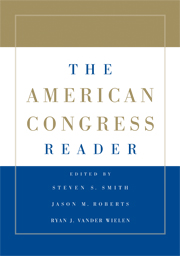Book contents
- Frontmatter
- Contents
- THE AMERICAN CONGRESS READER
- PART I THE AMERICAN CONGRESS: MODERN TRENDS
- PART II REPRESENTATION AND LAWMAKING IN CONGRESS: THE CONSTITUTIONAL AND HISTORICAL CONTEXT
- PART III CONGRESSIONAL ELECTIONS AND POLICY ALIGNMENTS
- PART IV MEMBERS, GOALS, RESOURCES, AND STRATEGIES
- PART V PARTIES AND LEADERS
- PART VI THE STANDING COMMITTEES
- PART VII THE RULES OF THE LEGISLATIVE GAME
- 20 Sample of a Special Rule
- 21 Sample of a Unanimous Consent Agreement
- 22 On the Effects of Legislative Rules
- 23 The Partisan Basis of Procedural Choice
- 24 The Evolution of Agenda-Setting Institutions in Congress
- PART VIII THE FLOOR AND VOTING
- PART IX CONGRESS AND THE PRESIDENT
- PART X CONGRESS AND THE COURTS
- PART XI CONGRESS, LOBBYISTS, AND INTEREST GROUPS
- PART XII CONGRESS AND BUDGET POLITICS
- PART XIII FURTHER READINGS ON CONGRESSIONAL POLITICS
24 - The Evolution of Agenda-Setting Institutions in Congress
Path Dependency in House and Senate Institutional Development
Published online by Cambridge University Press: 05 June 2012
- Frontmatter
- Contents
- THE AMERICAN CONGRESS READER
- PART I THE AMERICAN CONGRESS: MODERN TRENDS
- PART II REPRESENTATION AND LAWMAKING IN CONGRESS: THE CONSTITUTIONAL AND HISTORICAL CONTEXT
- PART III CONGRESSIONAL ELECTIONS AND POLICY ALIGNMENTS
- PART IV MEMBERS, GOALS, RESOURCES, AND STRATEGIES
- PART V PARTIES AND LEADERS
- PART VI THE STANDING COMMITTEES
- PART VII THE RULES OF THE LEGISLATIVE GAME
- 20 Sample of a Special Rule
- 21 Sample of a Unanimous Consent Agreement
- 22 On the Effects of Legislative Rules
- 23 The Partisan Basis of Procedural Choice
- 24 The Evolution of Agenda-Setting Institutions in Congress
- PART VIII THE FLOOR AND VOTING
- PART IX CONGRESS AND THE PRESIDENT
- PART X CONGRESS AND THE COURTS
- PART XI CONGRESS, LOBBYISTS, AND INTEREST GROUPS
- PART XII CONGRESS AND BUDGET POLITICS
- PART XIII FURTHER READINGS ON CONGRESSIONAL POLITICS
Summary
Roberts and Smith recount the origin and history of the two primary agenda-setting mechanisms in the U.S. Congress – special rules in the House and unanimous consent agreements in the Senate. They argue that the lack of an effective means of cutting off debate in the Senate put the Senate on a path of inefficiency, whereas the House was able to develop an efficient means of agenda control.
INTRODUCTION
Scheduling legislation is one of the most vexing collective-action problems faced by a legislative body. When the combination of must-pass legislation and legislation wanted by individual members exceeds the available time and resources, choices among alternatives must be made. These choices about the form and content of the legislative agenda create winners and losers, so it is important that we understand how these agenda-setting institutions emerge and develop. We focus on the two most important agenda-setting institutions in the U.S. Congress – special rules in the House and unanimous-consent agreements (UCAs) in the Senate.
THE MOTION ON THE PREVIOUS QUESTION AND PATH DEPENDENCY
A potentially strong path dependency exists in the development of congressional agenda-setting mechanisms. This path-dependent process is stronger than those usually encountered in processes of institutional change. Pierson describes path-dependent processes that are a product of the increasing returns of an institutional arrangement. In fact, increasing returns are a common, maybe the most common, form of path-dependent processes. With little difficulty, we can see this form operating in Congress, too.
- Type
- Chapter
- Information
- The American Congress Reader , pp. 265 - 276Publisher: Cambridge University PressPrint publication year: 2008

